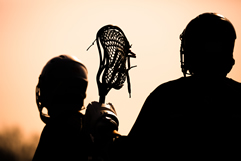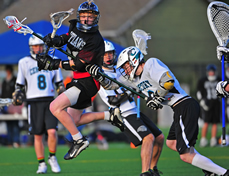
Sports Vision Training consists of the learning and training of Dynamic Visual Skills – that is “Vision in Motion”. These skills include Accommodation and Convergence, Anticipation Timing, Concentration Under Stress, Depth Perception, Eye-Hand Coordination, Peripheral Awareness, Speed and Span of Recognition and Visual Reaction Time. (For more in-depth explanations, see the attached Visual Skills definition sheet.) These are all learned skills that can be improved with practice.
Lacrosse is a game that requires intense concentration and awareness of what is happening around the player. A slight deficiency or lapse in either of these areas can mean mental or physical error or much worse – injury!
As lacrosse is a sport of almost constant motion, for the players and the ball, well developed dynamic acuity is just as significant as good static acuity.
The following is an explanation of the most relative dynamic visual skills associated with each position.

The ability of the eyes to work in unison while tracking a moving object (the ball or ball carrier, etc.) and to change focus instantaneously – as the distance of that object changes in relationship to your own position. This can be particularly important for the victim of a two on one, or for the goalie when facing the long shot, or as it is often mistakenly referred to “the easy shot”. Actually, it can be extremely difficult to handle for a goalie with accommodation problems, as the eyes must adjust so rapidly over such a great distance in order to keep the ball in clear focus all the way.
Most miscues occur not because of the action taken, but rather when the action was taken. The player caught out of position usually reacted too soon or too late due to faulty visual information regarding when to perform. A goalie who is down on the ground when the ball goes in the top corner of the net has committed himself too soon. Offensively, anticipation timing helps decide where a teammate is going to be; where to pass the ball; when to make a move around his opponent; or when to break for holes in the defense. Defensively, anticipation timing contributes to deflecting passes and well timed checks.
The ability to concentrate on the task at hand despite harassment, crowd noise and numerous other distractions. It is important to maintain this concentration (focus) even when fatigued. A goalie must be able to keep his/her focus on the ball through a maze of players and must also be able to maintain high levels of concentration, to keep him/herself in the game, when the majority of action is at the other end of the field.
Depth perception is a critical visual skill for a goalie. Excellent depth perception allows him/her to judge the distance, speed and direction of the ball as it approaches the goal. Players need to know where their teammates are in relation to the opposing players in order to make effective passes. In a one on one situation, good depth perception helps you judge when to make your move in relation to the defensive player between you and the goal.
Lacrosse is a very fatiguing sport which requires excellent conditioning. Physical fatigue can greatly affect concentration, visual reaction time, and eye-hand coordination. Eye fatigue can also affect performance levels in much the same way. When the muscles in our eyes feel tired or strained, we feel the fatigue all over. Just like a weight lifting routine is used to increase physical endurance, visual exercises can be used to strengthen the eye muscles and thereby reduce fatigue.
The process of taking a pass and accurately shooting to the open part of the goal is one of the prime examples of this skill. Eye-hand coordination plays an important part in deflecting shots and knocking down passes in order to control the ball, or in helping a goalie to make a save.
The ability to focus on the appropriate key (i.e. ball carrier) and still maintain an awareness of overall play/action including the position of all other players on the field. Peripheral awareness is essential in tracking both opponents and team players outside the major focal point in order to avoid a miscue or possible injury, commonly referred to as “see ball, see ‘man’” positioning. Maintaining an awareness of all the options for play development will help to keep the player from being caught out of position. It also allows the players to use a “heads up” playing style and still be confident in his ball handling.
The speed of the game demands that players take in and absorb many different actions at one time. A player must keep his/her focus on the assigned task but must also absorb and interpret other actions developing on other parts of the field. The faster the speed and the greater the span, the less likely a player will be caught out of position.
The faster a player processes visual information, the faster he/she is able to initiate a physical response. By improving visual reaction time, players more consistently follow the flow of play and respond more effectively as the play develops. Excellent visual reaction time can help a player create a turnover; control a rebound; help a goalie make the save; a center to win the draw/face-off; or be the difference between avoiding or taking a body/stick check at the wrong time.